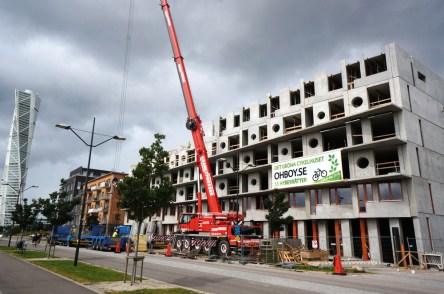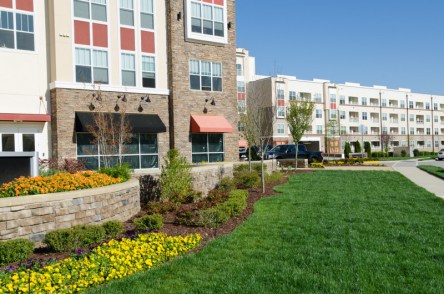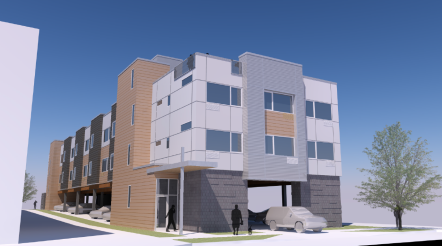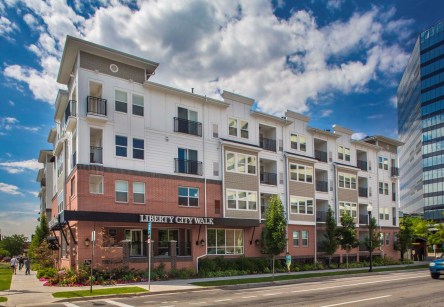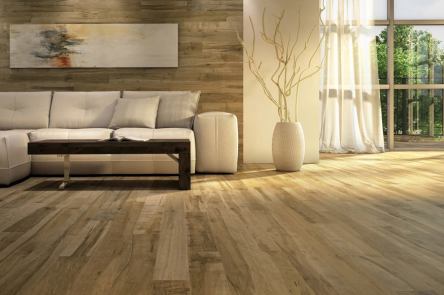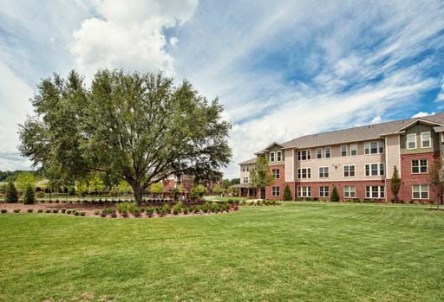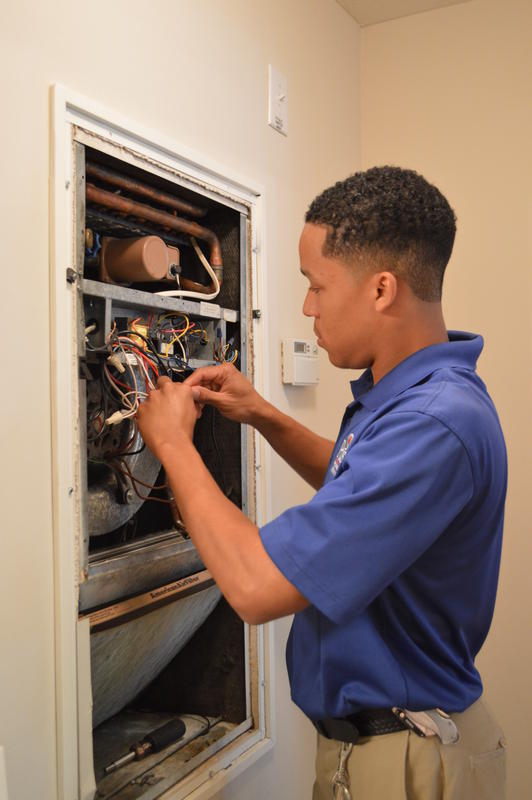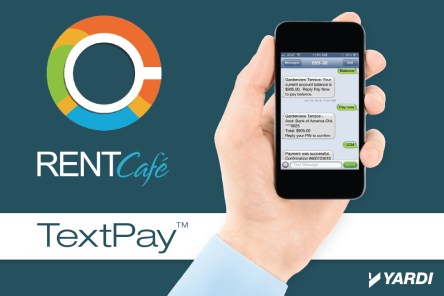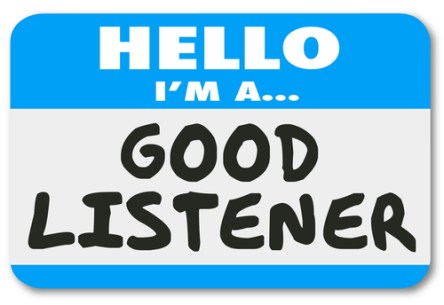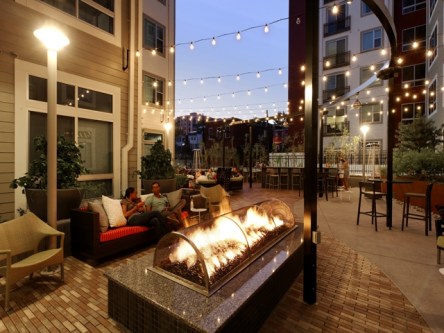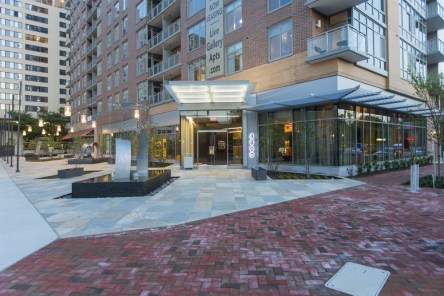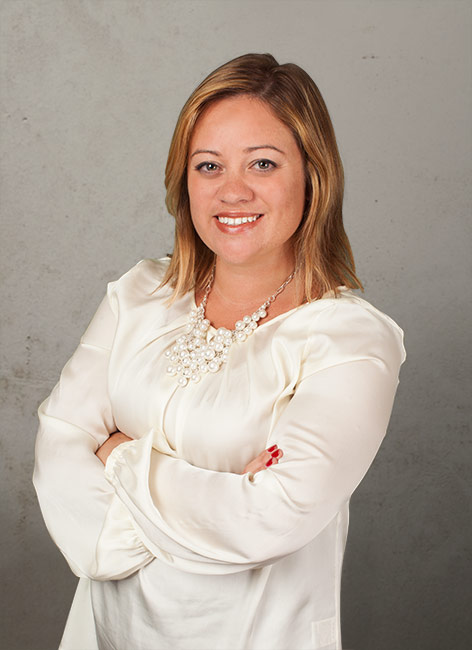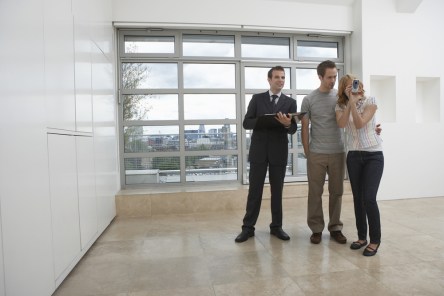Looking for a way to get more involved with the local community? Move for Hunger is a nonprofit that connects you, your residents, and your local food bank. Move for Hunger partners with the American Moving and Storage Association to get nonperishable food into the hands of those in need. Before relocating, residents coordinate with their moving company to deliver unwanted goods to local food banks. To date, the organization has transported more than 11,479, 245 pounds of food to food banks. The donations created 9,566,038 meals for people facing food insecurity. You and your residents can get in on the giving! Arranging a Move for Hunger Donation Setting up a Move for Hunger donation is incredibly simple. First, residents must find a participating professional mover. There are more than 1,000 to choose from across the United States. (And since residents are relocating, anyway, this step is super practical.) The residents and the mover will set up their moving date. While the residents are packing their belongings, they set aside the nonperishable items that they’d like to donate. On the day of the move, the mover will transport the nonperishable food to the nearest local food bank. Benefits for Residents Residents are looking for a way to quickly and easily clean out their unit. Move for Hunger helps them do just that. • All the food that they can’t eat before the move is relocated, rather than tossed in the trash. Donating the unwanted food requires no additional legwork for residents. • The food pick-up may potentially minimize the cost of the move! By donating items in the fridge, pantry, and cabinets there will be fewer boxes to move while residents are being charged. Benefits for You! By promoting Move for Hunger, you’re doing...
Pedal Power
Bike Apartments
In bike-friendly Sweden, a new apartment complex includes custom design elements aimed at encouraging residents to ditch cars in favor of pedal power. For many urban apartment dwellers, parking spots and constant traffic severely undercut the benefits of living within the city limits. Sure, public transportation, walking, and cycling are all reasonable alternatives to private automobiles, but sometimes the hassles outweigh the benefits. In Malmö, Sweden, a new apartment complex is ditching carports for bike racks in the hopes that future tenants will embrace a car-free existence. “It’s a perfect city for biking,” says Cykelhuset Ohboy spokesperson Ellen Mendel-Hartvig. “It’s super flat, and you can get anywhere within 15 minutes.” Centrally Cycling Located just minutes from the city center, Cykelhuset Ohboy, a 7-story bicycle house/hotel, is an easy trek by foot or bike from major shopping districts and even the central train station. Large delivery mailboxes will help resident shop online for items that might be too difficult to transport without a car, though the building’s fleet of cargo-bikes will also help with heavy loads and even help parents transport their children to school or daycare. “The strategy is to look at why people have to use cars, and substitute bikes, “Cord Siegel, one of the architects at Hauschild + Siegel, which designed Cykelhuset Ohboy, tells Fast Company in a recent interview. The Un-Motor Lodge In addition to 55 one to four-bedroom units, Cykelhuset Ohboy will also double as a hotel, with 31 lofts available for nightly rentals. Available for shorter tenancies – a few weeks to a month or two, the 237-sqft lofts include a small kitchen and can sleep up to three people. In a play on the traditional “motor-lodge,” guests will be able to ride their bike right up to their...
Passive Retention
Maximizing landscaping
As building permits increase this year and healthy competition is restored, multifamily must revisit resident retention practices. Luxury amenities, home automation technology, and quarterly vacation giveaways are unsustainable: amenities and technology quickly become outdated, requiring costly upgrades, and it’s hard to find room in the budget for grandiose vacation packages. What feature can increase tenant retention over the long term without significantly raising costs? Greenery. A series of studies suggests that renters can feel better about their communities and happier with themselves through strategic landscaping. According to a study released by Kansas State University, views of nature contribute to resident satisfaction by making residents feel happier and healthier. The lush landscaping and interactive green spaces in such residences enhance tenants’ sense of health and well-being by reducing stress and anxiety, invigorating the senses, and ameliorating urban harshness. The beneficial effects of nature apply to tenants of all ages. In “Visual Landscapes and Psychological Wellbeing ” by R.S. Ulrich, green spaces demonstrably improved students’ focus, productivity and confidence before taking tests. Greenery also decreased students’ stress levels. Housing that can offer students better academic performance and stress mitigation will be an easy sell in a competitive market. Mental Health and Function by University of Washington departments of Urban Forestry and Urban Greening Research compared seniors living in apartments with greenery to seniors without access to nature. Overall, seniors preferred greener communities. Seniors living near greenery used such spaces for recreation, exercise, and social interaction. As a result, they felt that green spaces contributed positively to their well-being, happiness, and vitality. Seniors revealed a positive correlation between greenery and a diminished sense of loneliness, fewer cases of depression, and lower mortality rates. Greenery can also improve resident retention by promoting peace between neighbors. Mental Health and...
Superstar Leasing Agents...
Their Top Traits
Deena Howell’s granddaughter sells an uncanny amount of Girl Scout cookies. “That’s because I taught her everything she knows about sales,” Howell smiles with a twinkle in her eye. “That’s why she’s so good at selling those cookies.” For nearly a decade, Howell worked as a leasing agent before becoming a trainer with her company. The skills she learned in the field benefited her throughout her entire career and well into her retirement as a leader in her granddaughter’s troop. Through her own experiences and training others, Howell has discovered seven pointers that help decent leasing consultants become stellar. Practice Empathy in Action Rather than selling from a script or promoting things that you like about the community, take the time to understand prospects’ needs and interests. Use those points to present the home that is right for them. “Make that unit seem like it was made for them rather than selling the first available unit. When you understand them, you understand what they need to hear and see.” Learn Active Listening Listening and processing information is vital to effective communication, especially with investments like a home. “Listening is the single best way to learn what the prospect really wants and how to sell it to them,” says Howell. “Even repeat info back to them to clarify. They will appreciate that you’re trying to understand them and they’ll trust your insights later on.” Sell Value, Not a Product “We don’t just sell a unit,” says Howell. “We sell a home, a lifestyle and possibilities.” The floor plan may encourage prospects to call but selling the lifestyle and the future possibilities will get them to sign the lease and renew later. Keep Learning About the Community This is especially important if you commute to work....
Introducing iUnit
Modular + Energy Smart
Believe it or not, iUnit is not the next device a certain ubiquitous technology company wants you to run out and buy. Rather, it’s a new modular housing project coming to Denver, Colo. in 2015, blending smart energy use, wireless connectivity, green construction and the urban living preferences of American Millennials. iUnit is intended to challenge the way we think about apartment living today, says founder Brice Leconte. A Washington, D.C. entrepreneur with a passion for startup technology, Leconte is currently an Entrepreneur in Residence at the University of Maryland as well as an advisor and mentor at Georgetown University. “iUnit is really a reflection of how I see the world and what I want to do with commercial real estate,” said Leconte, who worked on large single-family home developments early in his career. iUnit at Highland Park is his first foray into the multi-family space. We recently spoke to him about the project and what makes it unique. Tell us about iUnit. What’s it all about? Leconte: There are a lot of things in real estate that don’t make sense to me. One of them is on the modular front – why we are still building buildings out in the elements, while they are being rained and snowed on. I’ve wanted to build differently for a long time, and modular construction has always made sense to me. Building in a controlled environment, we end up with a much better, greener product, and better worker safety. That’s the method we’ve chosen for our multi-family building. We will use a factory in Idaho for the module construction. The other thing that has never made sense to me has how commercial real estate has lagged behind in integrating technology into its buildings. How can we introduce...
All-in-One Platform
Pinnacle Adds Yardi Products
Yardi announced today that Pinnacle has expanded its Yardi solution footprint, adding advanced ancillary services from the integrated Yardi suite of products to optimize its real estate marketing, leasing, financial and operational efforts with a single software platform. With an unwavering focus on exceeding expectations, Pinnacle sought a full business solution that would not only improve operational processes but help team members provide superior service to residents and also increase the value of each client’s investment. To achieve this, Pinnacle added products from the Yardi Multifamily Suite™ to its Yardi Voyager® platform and moved from their self-hosted environment into the Yardi cloud. According to Rick Graf, president and CEO of Pinnacle, “We require integrated best of breed solutions and a strong technology partner to provide our clients with unrivaled service and results. With Yardi, we have an all-in-one platform with mobility to meet our high management standards and surpass our clients’ expectations in the most cost-effective way possible.” He continued, “Yardi Voyager combined with RentCafe™, Yardi Resident Screening™, and Yardi Energy Solutions™ allows us to streamline our workflows through a single database for marketing, CRM, leasing, maintenance, accounting, utility billing, reporting, and more.” “We’re thrilled that Pinnacle has chosen the Yardi single-stack platform to achieve a full business solution that delivers a more competitive management offering,” said Terri Dowen, senior vice president of sales for Yardi. About Pinnacle Property Management Services, LLC Pinnacle Property Management Services, LLC is a privately held national real estate provider specializing in third-party management of multifamily residential communities. As one of the nation’s preferred third-party managers of multifamily housing, Pinnacle’s portfolio includes nearly 135,000 residential units and two million square feet of commercial assets. With corporate headquarters in Dallas, Texas, Pinnacle has 3,000 employees located in 35 states and...
Cowboy Properties
Happy residents on the range
Salt Lake City-based Cowboy Properties, Inc. has been managing apartment and condominium communities for decades now, attributing its success to its resident-centric take on business. “It all starts with happy residents. As simplistic as this principle may seem, at Cowboy Properties we’ve made happy residents our highest priority,” the company boasts. Cowboy Properties defines resident’s happiness as peace of mind, achieved through “responding quickly, and following through completely, to service requests,” as well as “respecting the trust that has been placed in us when a resident chooses one of our communities as home.” Cowboy Properties currently manages 20 apartment communities of around 3,000 units throughout the West, in Utah, Nebraska and Colorado. Utah is the focal point of Cowboy Properties’ activities, managing 16 completed communities in large urban hubs such as Salt Lake City and Park City as well as in smaller urban areas such as Sandy or Draper. Cowboy Properties manages the communities of affiliate Cowboy Partners, one of the top multi-family and mixed-use developers in the West. Cowboy Partners traces its organizational roots back to the 1950s. Projects developed by Cowboy Partners and managed by Cowboy Properties include Tregaron Senior in Bellevue, Nevada, Woodlands in Ft. Collins, Colorado, Liberty Peak in Park City, Utah and Liberty CityWalk in Salt Lake City, Utah. Cowboy Properties believes not only in a resident-centric business model, but also in giving back to the community. The company’s Cowboy Pledge initiative aims to connect residents looking to get involved and share their resources to give back to the community. The causes championed by the Cowboy Pledge are as varied as are collecting food bank donations, planting trees in local parks, assembling and donating backpacks with school supplies and helping redecorating patient rooms at the Ronald McDonald House. Residents...
Better Air Quality
From the ground up
What if your property could promote the health of its residents without increasing maintenance costs? You would have an undeniable marketing advantage with potential tenants who suffer from migraines, asthma and other respiratory ailments, as well as those who are simply health conscious. A new line of hardwood floors helps purify the air inside of units without increasing operating costs. But just how dirty is the air inside of your property? When most of us think of polluted air, we think about congested urban cores stifled under a cloud of smog. Surprisingly, the air inside of a home has 2-5 times more organic pollutants than the air outside. Several items in a typical residence emit volatile organic compounds (VOCs): paints, varnishes, glues, cleaning supplies, carpets, markers, copiers, printers—the sources of airborne toxins are endless. New constructions and recent remodels can be particularly toxic, as many building materials are laden with VOCs that are released over time. According to the Environmental Protection Agency, the constant onslaught of VOCs causes and exacerbates health issues such as migraines, asthma, fatigue, and damage to the lungs, liver, and kidneys. Many VOCs are confirmed carcinogens in humans and animals. Minimizing VOCs from the air can notably improve resident health, comfort, and satisfaction. Lauzon has created Pure Genius flooring, a natural solution for improved indoor air quality. Hard maple and red oak wood is treated with a titanium dioxide agent that is then activated by natural and artificial light. Photocatalytic technology transforms airborne toxins into harmless molecules. The floors continually break down toxins in the air overtime, improving air quality by 85 percent. It’s like planting three trees in each residence. Lingering odors are a frequently cited turn-off for potential residents. Lauzon’s smart floors minimize odors, making it a wise...
Walton Communities
Family Friendly Apartments
Since peaking in 2004 at 69.4 percent, U.S. homeownership rates have been slipping year after year. According to the latest Census Bureau data, the third quarter of 2014 ended with a nationwide homeownership rate of 64.3 percent, marking the lowest rate in 20 years. As a result, rentership is becoming more and more ubiquitous and not only among single, newly graduated Millennials and empty-nest Boomers, but child-rearing Gen Xers as well. Moreover, as the economy continues to recover and Gen Y ages, a growing number of Millennials are expected to start new households and families, continuing to fuel demand for family-friendly communities. One company that is focused on offering residents and their families a nurturing environment is apartment developer, owner and manager Walton Communities. The Marietta, Ga.-based company boasts a portfolio of 23 communities that include market-rate, mixed-income, signature and senior apartments throughout metro Atlanta and Augusta, Ga. Walton Communities on track to open three additional projects in fall 2015. The company strives “to develop real estate in a way that builds strong communities and improves quality of life.” Its commitment to family friendly living is even woven into the company name, which was inspired by The Waltons, that back-in-the-day TV drama starring America’s favorite family. A great example of Walton’s commitment to family-friendly living is the 181-unit Walton Oaks garden-style apartment community in Augusta, which recently opened a 106-unit second phase. Family friendly features include a lending library, controlled access for increased security, playground, picnic area with tables and grills and landscaping that includes over-sized oak trees. Clearly, families are encouraged to spend quality time together outside. Energy efficiency appliances help keep monthly expenses down, while a pet-friendly community policy allows children to enjoy the perks of suburban living. Walton Oaks, like many...
Mobile Maintenance
Top Ten Benefits
Mobile tools are all about immediacy and action — and when it comes to maintenance, that means responding more quickly, entering and completing work orders from the field, and getting real time updates to ensure the right work is done at the right time. Yardi Maintenance Mobile offers the convenience of creating, updating and closing work orders from a mobile device, with the ability to include photos and notes as well as add technician labor and inventory to work orders — and the information is automatically updated in Yardi Voyager®. For Wesley Fonseca, maintenance technician at Post Glen near Atlanta, Ga., Maintenance Mobile has been a game changer. “I’ve seen my time management get so much better with Yardi because of how I’m able to access the work orders on my smartphone. Maintenance Mobile has helped me save time in that I don’t have to print the work orders. I can map out my whole day and give certain spaces for emergencies and that sort of stuff. I have the ability to add and drop work orders, and sign them off in the field. Also, being able to have what I need at my fingertips, right on the spot, has helped me be more time efficient.” In addition to improving efficiency, mobile tools help improve retention by providing great service to residents and tenants. “Maintenance Mobile is a good selling point as far as the residents are concerned because everything is so technologically advanced now. They expect to see technology in use,” Fonseca says. “The residents have their place where they can put the different time of whatever day that they prefer for us to visit. They like being able to submit requests online, have us receive them, and then fix things and document...
RentCafe TextPay
Pay Rent Via Text
Yardi’s RENTCafé TextPayTM feature is the most recent addition to the software’s mobile payment functionalities, reducing delinquencies by giving users another convenient option to make rent payments on schedule. Residents opt into the service through the property’s resident portal, then set up the account from which payments will be deducted. Whenever they’d like to make a payment, residents can text “pay now” to a short code and then verify the payment. A confirmation marks the completed transaction. The TextPay service is free for residents and property managers as part of the RENTCafé resident services package. The mobile feature helps to decrease delinquencies by giving residents yet another option to conveniently make a payment: those who enjoy face-to-face interactions can still pay in person; those with steady fund availability can schedule a reoccurring payment online; and now those who desire the greatest degree of flexibility can pay through the app or via text. Robert Sang, Technical Project Leader, Programming with Yardi, believes that it’s the convenience of text-to-pay that makes the tool so effective. “The capability of making a payment from your mobile device at any time is appealing,” says Sang. “These features offer the residents a new comfort level when making payments by eliminating the need for a computer or check.” By offering a variety of payment options, property managers can help residents work around the barriers that hindered on-time payments. Limited leasing office hours, a lack of checks, no stamps, federal holidays—those delays are a thing of the past. Online portals and mobile payments make settling balances simple and convenient. Everyone stands to benefit. “Does it decrease delinquency? Absolutely,” confirms Sang. “I will tell you that we see greater through traffic in our resident services application between the 25th – 5th of the month....
Fannie Mae Goes Green...
Funding for Multifamily
Sub-metering has been known to help multifamily managers cut costs. Now, as part of Fannie Mae’s Green Initiative, the simple technology can help both multifamily developers and existing properties secure loans. Fannie Mae recently issued the report “Transforming Multifamily Housing: Fannie Mae’s Green Initiative and Energy Star for Multifamily,” which quantifies the benefits of energy efficiency on a blend of 1,163 multifamily properties. The data will be used to create standards for the Green Mortgage Backed Securities. The report reveals that the least efficient properties consumed at least three times more energy and six times more water per square foot than the most efficient properties. In addition to conserving potable water, preventing brownouts, and promoting cleaner air—all of which benefit the nation at large–green initiatives for multifamily can cut costs for property managers. It became clear that the benefits of sustainable development and upgrades for multifamily were worth Fannie Mae’s investment. The Transforming Multifamily Housing data will be used to create standards for the EPA’s Energy Star Score for multifamily as well as the Fannie Mae Green Mortgage Backed Securities. Properties that meet certain sustainability criteria will be eligible for a portion of $130 million in financing through Fannie Mae. Existing affordable properties will be eligible for Green Preservation Plus loans, which give borrowers access to as much as 85 percent of their property’s value as long as borrowers implement measures to reduce energy and water consumption. To meet required criteria, managers can take advantage of a variety of resource-saving options. Common sustainable upgrades can save a property 15 percent or more on energy and water costs each year. One approach that has proven its value for senior, affordable, and convention multifamily properties is sub- metering. Properties with sub-metered utilities can drastically reduce costs;...
Building Community
Winter Event Ideas
The warm weather months are kind to leasing agents. Residents don’t need much incentive to come to the outdoor community parties. The colder months, however, can bring the fun of an active community to a grinding halt. How and where can onsite staff host resident events during the colder months? We’ve got four fun community event ideas that are indoors, affordable, and sure to build a sense of community and belonging for your residents. Lease renewals, anyone? Local Gym During the winter, many people are planning or executing their New Year’s fitness resolutions. Local gyms are eager to recruit new members and you’re eager to find an affordable, fun place to host a party. Pick the best equipped gym near your community and let your interests combine! Work up a deal with your local gym: request free guest passes (which most gyms offer anyway) and you’ll supply their potential, future members. Get residents together for games of basketball, racquetball, or popular Zumba and yoga classes. The more that the gym has to offer, the more opportunities your residents have to bond and maintain their New Year’s resolutions. The best part: residents will likely join the gym and find workout buddies amongst neighbors, adding two more reasons for them to love your community. Aquatic Center Who says you can’t swim in winter? Check out your local aquatic center, often hosted by the county. Many centers, especially those constructed within the last decade, have indoor pools, heated indoor pools, saunas and hot tubs. Space rentals are often quite affordable, especially in the winter when business is slow. All that is left for you to do is supply a few light snacks (because no one wants to swim on a full stomach). Dave and Busters D&B offers...
Special Delivery
Managing Packages
More than 37 million U.S. apartment residents receive enormous numbers of holiday packages every year. A load that large requires more than mere tracking numbers. For that reason, one in four apartment communities use specialized software to manage residents’ packages on site. These are among the findings from the National Multifamily Housing Council (NMHC) and Kingsley Associates’ 2014 Package Delivery Survey. The survey was fielded in October of this year, with 2,758 community managers from 28 leading firms responding. The survey also found that during the holiday season, a typical apartment community can receive double the typical 100 packages received weekly. After all, consumers spent $2.3 billion on Cyber Monday in 2013 alone. In more than three-quarters (77 percent) of apartment buildings surveyed, package carriers try to deliver to the door, as opposed to going to the manager’s office, but the number drops to one in five (20 percent) in high rises. If residents aren’t in, carriers take packages to the management office 70 percent of the time. This results in an enormous number of packages for the community manager to handle. “Managing deliveries is a real issue facing the industry,” says David Smith, chief operating officer and vice president, San Francisco-based Kingsley Associates. “There is inherent risk and valuable time associated with sorting, storing and notifying residents of package deliveries at the community level. Senior executives are clearly taking note of the escalating staff hours spent managing the process, particularly during the holidays.” Many apartment companies are increasingly adopting software solutions to help them get a handle on packages. Almost one-quarter, or 24 percent, of properties utilize software to track packages and notify residents. Among high-rise apartment communities, 60 percent are relying on specialized software. Apartment managers are as likely to notify residents...
7 Winter Defenses
Maintenance Tips
Winter is in full swing, bringing with it unpredictable cold fronts and unpleasant, icy storms. Keep your property and residents safe with these simple tips for winterizing your apartments. For Owners HVAC Tune-up Seasonal inspections of your heating and cooling systems will ensure that they are operating at optimal efficiency. It’s also a great idea to make sure that ducts are properly sealed and insulated, which can cut costs by 20 percent or more according to EnergyStar.gov. Stock Up on Salt Make sure that you have enough salt to help defrost walkways, exterior stairways, and inclines throughout the parking lot, entrances, and exits. If the weather drops below 16 degrees for several hours, you may consider a beet juice, molasses, and cheese brine defrosting cocktail. If your community rarely experiences freezes and doesn’t have a plan in place, speak with your maintenance team to set a schedule or assign a technician in charge of defrosting the premises. No one wants to be surprised with such a task at 4am. Arborist Inspection Have an arborist inspect trees for rot, damage, disease, and pests. Branches that are weighed down by snow and ice are prone to fall when they’re already weak. The National Storm Damage Center reports that trees damaged by severe weather cause more than $1 billion in property damage each year. The arborist’s inspection could save you millions by preventing property damage and injury to your residents. Text Alerts If your property does not have a text-alert system for residents, consider establishing one. Use this system to notify residents of extreme weather conditions and fallen trees across nearby thoroughfares. It’s a small touch that can save time and keep residents safe. Extinguisher Check Be sure that fire extinguishers are inspected per fire department code. Scheduling inspections in the...
Resident Retention
Better Communication
Reducing turnover (and loss of revenue) requires multiple factors working together in harmony, such as a great location, beautiful homes and amenities, and a maintenance crew that is always on point. But perhaps most importantly, the relationship that renters build with the onsite staff can make or break a lease renewal. Fortunately for onsite staff, developing good social skills won’t require an additional line in the budget and it can make a world of difference for retention. Let’s take a look at three points that can improve relationships between staff and residents, leading to happier days and longer stays. Visual Connection It’s a basic social convention that many of us avoid for one reason or another but eye contact is a skill that will take you far in multi-family services. Eye contact is vital for successful during face-to-face communication, whether you are the listener or the speaker. Studies show that listeners are more likely to trust what you say and have confidence in your abilities when you visually connect with them. As you listen, eye contact becomes equally important. When you fail to make eye contact with your residents, you risk conveying: A lack of interest in the speaker: “I’m too busy to pay attention to you.” A lack of interest in the matter at hand: “Oh look… a squirrel is outside.” Dishonesty: “I can’t look him in the eyes while I try to wiggle out of this.” Dominance: “You’re unworthy of my attention.” A lack of eye contact can put a resident in defensive mode, offended by your nonverbal cues and ready to counterattack. This can quickly turn a simple complaint or concern into an argument. The resident will be harder to please and more likely to express aggression on review boards and...
Lifestyle Oriented
Multifamily goes swank
Resort-inspired waterparks. Cultural cafés. Vegetated roofs. Walking and biking trails inviting to active lifestyles. These features may not have had a place in urban residential developments in the past but they are now a gratifying reality. Today’s multi-family communities offer much more than just a place to live. They have evolved into inclusive live-work-play environments where emphasis is laid on occupant health and well-being. Strong demand for rental housing combined with a prospering economy and consistent population growth have allowed developers to deliver an enhanced product, abounding in contemporary design elements, tech offerings and quality services. Many communities around the country are being rebranded, reinvented or revitalized so as to cater to the lifestyle needs of the nation’s key renter demographic, the so-called Millennials. Award-winning national architecture and planning firm KTGY Group, Inc.’s thought-leader Rohit Anand, AIA, NCARB, and the managing principal in KTGY’s Tysons, Va. office, says that Millennials, defined by many demographers as ranging from ages 18 to 37, make up the largest population segment the U.S. has ever seen. “Millennials have many names. They have been referred to as Generation Y (the generation to succeed Generation X), The Echo Boomers (refers to the fact that many Millennials are children of Baby Boomers), The Net Generation (since Millennials grew up with the Internet), The Boomerang Generation (since so many Millennials move back in with their parents after going away to college) and The Peter Pan Generation (due to that so many Millennials delay the rites of passage into adulthood longer than most generations before them),” Anand said. “The Millennial generation has already made a big impact on student housing. The number of students enrolled in college in the U.S. climbed by 30% from 2000 to 2011, helping to fuel a building boom...
Instagram Hyperlapse
Easy Mobile Video
If you haven’t looked into Instgram now is the perfect time to reconsider. Instagram has launched its standalone companion, Hyperlapse, to appeal to the Vine crowd without…well, the Vine crowd. Hyperlapse offers mobile video production that’s quick, simple, and eye catching. In other words, it’s just what you need to take your content marketing to the next level. Hyperlapse helps mobile users create silent videos that are 15 seconds in length or fewer. This is more than double the video length available on Vine, allowing you to offer a fuller presentation of your content while maintaining your audience’s short attention span. Effortlessly create seamless video tours of a unit or longer videos showing what the surrounding community has to offer. It’s also a good tool for sharing clips from community events. Anyone can create a good video with Hyperlapse thanks to the ultra-simple process: record up to 45 minutes of video, alter speed as needed, save, and share. Your staff won’t need a media degree or innate tech-savviness to operate the app. Hyperlapse is just that straightforward. While simplicity is an excellent feature, it’s the quality of Hyperlapse videos that will really make your content stand out. Built-in image stabilization (via the phone’s gyroscopes) gives the videos a smooth, professional finish rather than looking like bumpy scenes from The Remaining. This app can potentially save you money. Create awesome videos with fewer calls to your professional videographer. Prospective users will be glad to know that you don’t have to create a new presence on the app. It’s a pain to build and maintain a following on a new social media platform, especially when we don’t know which apps will be hot or not in the next six months. Hyperlapse cuts the drama by allowing you to...
PACE Awards
Yardi Clients Honored
Several Yardi clients were recognized this week by the Property Management Association’s (PMA) Apartment Community Excellence Awards (PACE). Categories included market rate and government-assisted housing, along with green initiative communities, resident retention programs, and communities that make a difference in their hometowns. Habitat America was recognized for several properties, including Clare Court, which was honored in the Affordable Maryland category. The Clare Court complex offers a mix of apartments and townhomes within an intergenerational collection of residents. In addition to living in a supportive community, residents give back, enhancing the greater community through mandatory volunteer activities and training. Vantage was awarded in the lease-up category for its management of the luxury high-rise Gallery Bethesda (pictured at right), a recently completed community owned by the Donohoe Group. Ever- innovating, yet never losing focus on their client’s goals, Vantage has managed family-owned portfolios in the multifamily industry for 40 years. Properties were recognized in the Washington, D.C. metropolitan region including communities in Maryland and Virginia. According to PMA Executive Vice President Thomas B. Cohn, “PACE recognizes exceptional apartments and identifies communities that are passionate about providing exceptional resident services and delivering unparalleled living experiences. PACE not only celebrates excellence in the management of apartment communities, it also fills a void. PACE is the only awards program in the national capital region that evaluates apartment communities on their operating efficiencies and ability to deliver world-class customer service. Unlike many apartment award programs in other parts of the nation, PACE is not a beauty contest or a program to honor as many communities as possible. Instead, PACE looks to recognize truly extraordinary properties that are the best of the best.” Yardi clients were also recognized in the following categories: Habitat America : http://www.habitatamerica.com/ Category: Affordable Maryland Property...
Halloween Safety
For All Treats, Fewer Tricks
During this time of year, your office is likely gearing up for ghoul-themed, candy-laden parties for your residents. A few simple tricks can help minimize risks to guests and keep your Halloween party fun and fright free. On the day of the event, you’ll likely be busy running through the office, putting up last minute decorations and arranging the food. That’s why it’s worthwhile to print a safety checklist. Decorating and Activities Make sure that hanging bats and flying ghosts are properly supported. Tug a little to make sure that you encounter resistance. Be mindful that if it’s low enough for a child to pull, a child will pull it. Avoid unnecessary fire hazards by inserting LED “candles” or glow sticks into jack-o-lanterns and glowing décor. It never hurts to have an officer on guard. Simply having the patrol car in the front of the community will remind residents to abide by the speed limit as trick-or-treaters are making their rounds. For pumpkin carving contests, minimize risk of injury by providing markers and other alternative decorating items for younger participants. Electronics Ensure that any cords that run through a walkway are smoothed out and visible to guests. If you’re fortunate enough to have warm weather in October, practice pool safety. Set up electronics a safe distance from the pool. What’s enough space? Imagine that the item fell over. If it would land in the pool, it’s too close. A few nights before, be sure to have the maintenance crew check the property for inadequate lighting, damaged lamps, or burned-out bulbs. Have all lighting in top-notch condition before trick-or-treating festivities. Food and Beverage Selling or offering drink tickets is a convenient way to moderate alcohol intake at adult parties. Severe food allergies are a buzz...
Buckingham Companies
Marketing in motion
Buckingham Companies may have forged its identity as a leader in commercial real estate but its multifamily properties have established their own reputation. In 2013 alone, the company received 19 awards for its singular properties. Spreading the word about Buckingham Companies’ award winning properties is an equally distinguished marketing department. The staff was honored with a Prodigy Award for Best Overall Marketing Program, another for Best Color Advertisement, and the Bronze Adrian Award for Complete Campaign and Posting. Nicole Crosby, Marketing Manager, believes that the trick to modern marketing is for the department staff to quiet its own assumptions. “It’s less about what we have to say and more about what customers have to say. We’re just trying to do a better job of monitoring what our customers are saying and leveraging that feedback to use in our marketing campaigns,” says Crosby, pictured at right. “We can’t rely on what we think is great about our communities. We have to listen to what our customers have to say and use that as our marketing message.” Buckingham Companies’ approach appeals directly to Millennials, whose social media usage serves as a direct line of communication to the marketing team. The team’s attentiveness has paid off. From feedback and observation, Buckingham Companies decided to capitalize on the popularity of Buffalo Wild Wings restaurants and a common housing woe: roommate dysfunction. “We did a marketing piece where we gave the students one of the BW3 wet naps attached to a little card that went out with the to-go orders that said, ‘Things are about to get messy. We’re here to help.’ Then on the other side of the card, we mentioned, ‘Now let’s talk about your living situation,’” laughs Crosby. The card gave students details about local properties....
Back on Track
Apartment markets improve
The U.S. apartment market is getting back on track. As of July 2014, 386,000 units are underway, shows Fannie Mae’s Housing Industry Forum. Multifamily research firm Axiometrics reported that year-to-date effective rent growth was the highest since the Great Recession, with June 2014’s YTD effective rent growth clocking in at 4.5 percent. Class B properties continued to provide the strongest growth among all asset classes at a 4 percent effective rent growth. Occupancy also shows a positive YTD growth, inching up from June 2013’s 94.8 percent to 95 percent for June 2014. Revenue growth is also on an upwards swing at 3.9 percent in June. MPF Research data shows that professionally managed apartments experienced a 3 percent rent increase in 2013. The growth rate was double at 6 percent in the 20 most rapidly appreciating markets, most of which are located in Northern California, with Denver and Corpus Christi also making the cut, shows Harvard University’s Joint Center for Housing Studies. Nominal rents for contract rents went up 2.8 percent in 2013, only slightly more than 2012, according to the consumer price index (CPI). Professionally managed properties with five units or more increased rents by 3 percent, somewhat more restrained than the previous year’s 3.7 percent. Overall, rent growth outpaced the overall inflation rate of 1.5 percent. Multifamily starts grew by a whopping 25 percent in 2013, surpassing the 300,000 unit marker for the first time since 2007. New York (30,000), Los Angeles (17,700), and Houston (16,800) issued most permits, while Atlanta, Baltimore, Detroit, and Riverside had the largest growth rate. Overall, 67 of the top 100 metros saw multifamily permitting increase in 2013 with 50 of the largest metros’ construction levels returning to mid-2000s levels. Permitting exceeded 2000s averages in 47 of the...
MultiGen Multifamily
Which cities have the most combined homes?
Pew Research reports that there are now more than 57 million Americans living in multi-generational homes. Traditional single-family products no longer meet the needs of today’s cross-generational households, paving the way for multigen, multifamily communities that offer flexible alternatives. The uptick in multigen housing began in the 80s, inching from 12.1 percent of households to 18.1 percent in 2012. The top ten cities to experience the greatest growth include: El Paso, TX Madison, WI Cincinnati, OH Columbia, SC Little Rock, AR Ogden, UT Boston, MA Sacramento, CA Honolulu, HI Jacksonville, FL In the traditional approach to multigen housing, parents move into renovated spaces or detached cottages on their adult children’s property. This isn’t a feasible option for every family because some existing homes don’t have the space or families don’t have the funds to make structural changes. In 2012, single-family developers began marketing multi-generational products that don’t require costly renovations or add-ons. Lennar took the lead with NextGen, a model with two master suites and private entries, essentially providing two homes under one roof. Ryland Homes also offers a comparable multigen product, customizing properties to include separate kitchens. While these houses furnished a new way for families to unite, they create additional problems. Primarily, such single-family arrangements don’t address the significant number of seniors who do not want to impose on their children, or whose children can’t afford new construction or add-ons while still recuperating from the recession. AgingCare depicts the struggle between seniors’ desire for independence and feasible housing scenarios. 46 percent of seniors believe children have a responsibility to provide financial support to their parents or in-laws, allowing a parent to live with them if he or she is unable to thrive alone. Oddly, many parents say they would not accept financial assistance from their children. In a similar survey by Gallup & Robinson, only 31 percent of those surveyed said they would live with a younger family member when they could no longer live on their own. In short, seniors want their children to offer support but many parents don’t want to become dependent. Financial strain is a major deterrent. Certified financial planner Kevin Young has seen a growing number of working adults struggling to make ends meet. He tells US News, “They’re taking care of aging parents and children at the same time, sometimes working multiple jobs to accomplish that.” The “sandwich generation” is having difficultly saving for their retirement and their children’s education. Seniors are aware of these tensions and don’t want to be a burden. Secondly, most new single-family communities are developed in the suburbs, far from public transit, work hubs, and other amenities that are priorities to seniors; within a half mile distance from home, seniors would like to have a doctor’s office, grocery store, hospital, place of worship and drug store according to an AARP study. Multifamily construction addresses many seniors’ concerns at once. Apartment communities are better suited for infill projects, placing seniors closer to the pedestrian-friendly amenities that they desire. Mixed-income apartments offer budget-friendly options for seniors and their adult children. The community layout facilitates living within walking distance of loved ones while maintaining a degree of autonomy for both parties. Avalon West Hollywood, for example, is a mixed-income community that will consist of two LEED Silver market rate complexes and a LEED Gold senior building. It allows younger adults to live in close proximity to their aging parents while maintaining independence and privacy. Particularly important to seniors, Avalon West Hollywood’s location near public transportation provides easy access to shopping, recreation, and health care facilities. Affordable housing is also exploring cross-generational projects like Courier Place in Irvine. Courier Place caters to working families and seniors, located near public transit and major employment centers. LEED Platinum certification encourages environmental and financial benefits to seniors with limited incomes and growing families. Multifamily is also rolling out budget-friendly solutions for seniors who...
Top 5 Resident Complaints...
Smarter ways to solve them
J Turner Research analyzed 10,000 customer satisfaction surveys from multi-family communities throughout the nation to determine the top resident complaints. The results reveal that renter satisfaction does not depend on a slew of custom features and amenities. Rather, four out of five complaints depend solely on how onsite staff manages priorities: 1. Rental rates 2. Poor grounds/common area upkeep 3. Disorganized staff/lack of communication with staff 4. Quality of response to maintenance requests 5. Overall customer service experience Yardi clients weigh in on how they handle multi-family’s most ubiquitous complaints. Rental Rates There is little that onsite staff can do to influence long term rent rates. That’s why it’s important for staff to hone in on the assets around them, reminding residents that they are paying for the unit and all that the location has to offer. Larry Busgeon, Controller at Landmark Realty of San Francisco, has no issue with marketing exceptionally high rents. The prices are a great value because the city has so much to offer. “It’s a wonderful place to live and you have to pay to live in a highly desirable area,” says Busgeon. He’s ready with a list of the city’s best features: restaurants, culture, cutting edge environmental programming, a unique political atmosphere, great schools, natural beauty, and moderate weather year round. Finding ways to forge a direct relationship between the property and what the community has to offer will add value for residents. Staff may create alliances with local businesses, sending customers their way in exchange for discounted goods and services. Maintenance Crews Whether landscaping and maintenance technicians are hired in house or through a third party vendor, they are still representatives of office management. As such, it’s important for onsite staff to make sure that technicians are staying...
The Best Bike Policy
Five Simple Steps
As an outdoor enthusiast, I love the warm weather months. It’s great to hop on my mountain bike and head to the local trails or just watch the kids cruise around the neighborhood while I grill. But I hate the heart-stopping moments when kids on bikes get too close to moving cars or when I can’t park in my space because a bike is hogging it. An apartment community without a bike policy is asking for trouble in more ways than one. A bike that lays discarded in the breezeway can be a fire hazard. An unattended bike can turn into a stolen bike which turns into a theft report and a community that seems unsafe. Lastly, bikes scattered throughout your community simply look like a mess. A solid bike policy can help communities maintain the joys of having an active bike population with less of the drama. These five simple tips will help you establish a community bike policy and stick with it! Set Up Proper Storage Be sure that bike racks are accessible, especially near areas where children congregate like the playground, pool, and near the bus stop. Encourage Bike Safety During your next outdoor event, invite a pro from a bike shop or outdoor supply store like REI and Performance Bikes to set up a presentation on bike safety. It’s free press for them and free safety info for your residents—a win-win situation. The presentation can start with a fun activity or demo to grab kids’ attention and then cover rules of the road, bike registration (which can be as simple as etching the owner’s name into the frame), and basic bike maintenance tips. Establish the Bike Policy Kids are kids. There is bound to be a lost or improperly stored bicycle now and then. That’s why it pays to have a bike policy. Include: A designated storage location for lost/discarded bikes A maximum duration of time in which the bike will be held at the storage site A maximum number of times that the same bike can be lost or discarded A bike claiming process A game plan for frequently misplaced and unclaimed bikes–bonus points if your game plan gives back to the community! In my old complex, the onsite staff would hold the bike for one week in a storage room near the pool. If the bike wasn’t claimed, it was then donated to the local SPCA thrift store which raises money for the no kill shelter. Be Proactive In addition to proper bike storage, learn more about biker and pedestrian options in your area. If those resources are lacking, become an advocate. Neighborhoods with bike lanes and pedestrian friendly access to local amenities rank high on renters’ lists. Besides, residents love to see their onsite staff having a positive influence in the neighborhood. It encourages a sense of community! Be Consistent Consistency promotes respect and fairness. If rules are sometimes enforced, they’ll never yield enough influence to be productive. Fairness will help onsite staff avoid disputes. Does your community have an effective bike...


